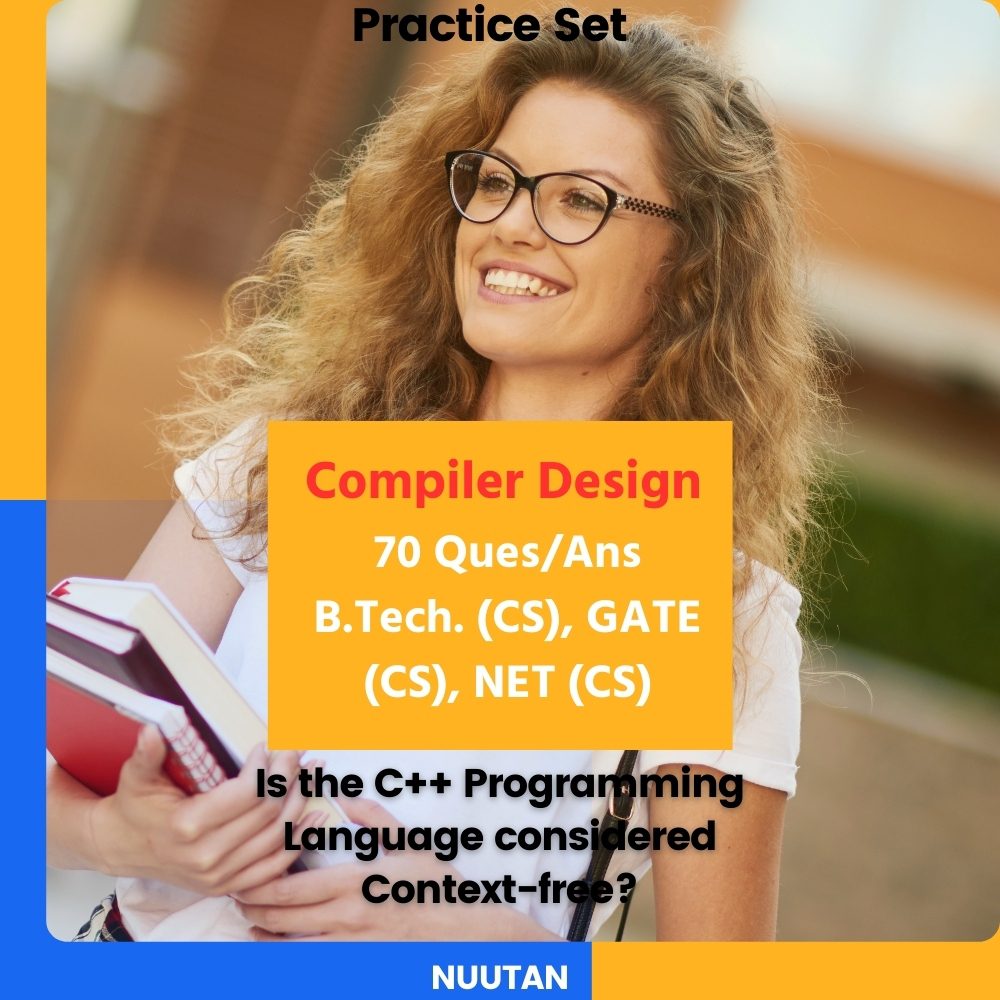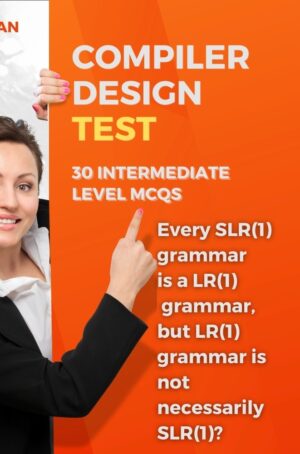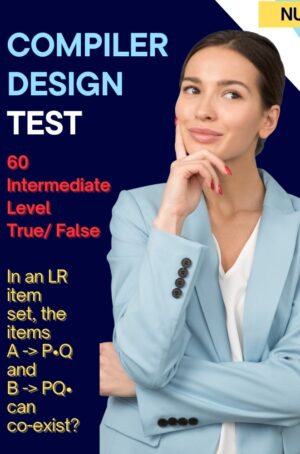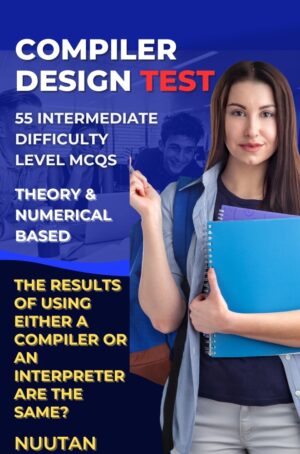Description
Master Compiler Design Skills with “Compiler Design 70 Q&A” Practice Set
Explore the Depths of Compiler Design Principles
Embark on a journey into the world of Compiler Design through our meticulously crafted “Compiler Design 70 Q&A” practice set. Tailored to cater to students both globally and specifically in India, this resource is designed to enhance your understanding of Compiler Design.
Tailored for Excellence: Compiler Design Worldwide and in India
Geared towards students pursuing degrees such as B.Tech, M.Tech, BCA, and MCA, our practice set is a valuable asset for mastering Compiler Design. Whether you’re a dedicated student aiming for academic excellence or preparing for competitive exams like GATE, NET, SLET, DRDO, and ISRO, this resource is your path to success.
Comprehensive Coverage: A Strong Grasp of the Subject Matter
Immerse yourself in a diverse array of carefully curated questions and answers. Our practice set covers a wide range of topics within Compiler Design, ensuring a comprehensive understanding of the subject. Each question and answer is thoughtfully selected to help you grasp Compiler Design principles thoroughly.
Empowering Your Journey: Unlocking Your Full Potential
Equip yourself with the knowledge and skills needed to excel in Compiler Design. Whether you’re navigating the complexities of Compiler Design for your academic pursuits or striving for excellence in competitive exams, our practice set provides the tools to help you realize your potential.
Guiding You to Success: Achieve Your Academic and Career Goals
Navigate your way to success with the “Compiler Design 70 Q&A” practice set. Tailored to students worldwide and in India, with a specific focus on Compiler Design, this resource accompanies you on the journey to achieving your academic and career aspirations.
Mastering Compiler Design: Your Pathway to Success
Confidently master Compiler Design principles with the comprehensive “Compiler Design 70 Q&A” practice set. As you embark on this educational journey, rest assured that you’re equipped with the knowledge and insights necessary to excel in Compiler Design studies and beyond. Your success story begins here.
Copyright:
© 2023 Nuutan.com. All rights reserved. The content titled “Compiler Design: 70 Q&A for Worldwide Students, Study Aid” along with its accompanying materials are the sole property of Nuutan.com and are protected under copyright law. Any unauthorized copying, distribution, or reproduction of the materials without prior written consent is prohibited.
To access the Nuutan.com practice set, please follow these steps:
- Begin by making a payment for this valuable academic resource.
- Once your payment is processed, you will promptly receive an email at your registered login address. This email will contain a password.
- Please be aware that the provided password will have a validity period of 15 days, counting from the date of your purchase.
- Embrace the opportunity to enrich your learning experience with the Nuutan.com practice set. Start your educational journey today!
List of questions:
Q1:
Is it accurate to state that interpretation and compilation processes occur offline and online, respectively?
Q2:
Is machine language interpreted by the central processing unit (CPU)?
Q3:
Can macro-syntax effectively address the challenges related to case sensitivity in syntax?
Q4:
Is parsing of the program carried out by the compiler’s back-end?
Q5:
Is there any distinction between a syntax diagram and context-free grammar (CFG)?
Q6:
Do compilers function as translators for various programming languages?
Q7:
Is it true that compilers exclusively generate low-level code?
Q8:
Is it possible for compilers and interpreters to coexist for a programming language?
Q9:
Within the “front end” of a compiler, there exist fundamental components such as the scanner, parser, and static semantics, collectively responsible for assessing the structure of the input program. In the context of the MiniJava language, a subset of Java, the interpretation of a MiniJava program can be inferred from its Java counterpart. Let’s examine a specific property or error: “The += operator is not supported in MiniJava.“ When encountering this limitation, is it the parser stage of the compiler’s front end that addresses and manages this issue?
Q10:
Do compilers and interpreters engage in semantic and syntactic analysis?
Q11:
Is it accurate that both the compiler and interpreter read the complete input file before initiating the translation process?
Q12:
Do compilers and interpreters engage in the optimization of the provided source code?
Q13:
In the context of syntactic analysis, does the process of parsing generate an abstract syntax tree that contains cycles?
Q14:
In the context of a cross-compiler, are the target and host languages the same?
Q15:
Does the equation “40 = x*4” contain a lexical error?
Q16:
Are the outcomes of syntax analyzers and semantic analyzers the same?
Q17:
Do compilers indeed produce executable binary object files, while interpreter generate intermediate code, and is it accurate that both types of output can be executed multiple times?
Q18:
Is it possible for a compiler to utilize the same language for both the source and target?
Q19:
Are there languages that can only be represented using Extended Backus-Naur Form (EBNF) and not with Backus-Naur Form (BNF)? Is this because EBNF is inherently more expressive than BNF?
Q20:
Is it the responsibility of the compiler’s lexical analyzer to examine every single character in the source text?
Q21:
Is C considered a context-free programming language?
Q22:
Is the C++ programming language considered context-free?
Q23:
Is it accurate to say that parsing C++ is more challenging compared to parsing C?
Q24:
Is it accurate to assert that both the grammars of C and C++ inherently contain elements of ambiguity?
Q25:
Is it accurate to state that Java exhibits a simpler parsing process than C, and similarly, that C boasts a simpler parsing process than C++?
Q26:
Is it accurate to assert that Java’s parsing process is notably simpler due to its utilization of the LALR(1) parsing method, especially when juxtaposed with the parsing processes of C and C++?
Q27:
Among the four LR parsing strategies, LR(0), SLR(1), LALR(1), and LR(1), the process of parser development involves constructing a DFA to identify viable prefixes. In terms of the size of state machines, is it accurate that both LALR(1) and SLR(1) recognize state machines of the same size?
Q28:
LR(0), SLR(1), LALR(1), and LR(1) are the four LR parsing strategies. At each stage of parser development, a DFA is constructed to identify viable prefixes. Is it accurate to say that there exists a disparity in size between LR(1) and LALR(1) state machines, with LR(1) state machines being larger than their LALR(1) counterparts?
Q29:
LR(0), SLR(1), LALR(1), and LR(1) are the four LR parsing strategies. During each stage of parser development, a DFA is crafted to identify viable prefixes. Can the LR(1) parsing approach also be applied in the reverse direction?
Q30:
LR(0), SLR(1), LALR(1), and LR(1) are the four LR parsing strategies. At each phase of parser development, the construction of a DFA to identify viable prefixes is essential. Let’s consider a grammar where the production rule is S -> x. In this specific case, is it accurate to say that the sizes of the LR(1) and LALR(1) state machines are equal?
Q31:
Among the four LR parsing strategies (LR(0), SLR(1), LALR(1), and LR(1)), each stage of parser development necessitates the construction of a DFA to identify viable prefixes. Can it be asserted that while parser generators are capable of producing LR parsers, human programmers typically find it challenging to manually create LR parsers?
Q32:
Is it possible that scanners do not understand the grammatical structure of a language?
Q33:
If a parse completes successfully, the input must have been semantically correct?
Q34:
Is an interpreter a software component that reads programming language source code and executes it incrementally, statement by statement (or expression by expression)?
Q35:
In the lexical analysis phase of compilation, what is the role of a compiler with regard to identifying language keywords within the source code?
Q36:
Within the front end of a compiler, which components are responsible for investigating the validity of the input program? How is the issue of variable declaration addressed, particularly when the error relates to a missing declaration in a dedicated variable declaration stage? Is this concern resolved during the semantic phase of the front-end compiler?
Q37:
Within the framework of a compiler’s front end, encompassing the scanner, parser, and static semantics, these constituent elements collectively engage in an analytical process of the input program to establish its structural configuration. Let us consider a specific aspect or situation: “A comment that commences with /* is not duly terminated before the conclusion of the input file (i.e., the closing */)“. When faced with this particular circumstance, does the responsibility of addressing and rectifying this error fall within the purview of the scanner phase of the front-end compiler?
Q38:
The scanner, parser, and static semantics collectively constitute the front end of a compiler. These components are responsible for conducting an in-depth analysis of the structure of the input program. Let’s consider the following error or characteristic: “MiniJava identifiers cannot contain ε”. Does the responsibility of addressing this error lie with the Scanner Stage, which is an integral part of the compiler’s front end?
Q39:
Within the realm of compiler front-end components—namely the scanner, parser, and static semantics—these integral constituents undertake the task of assessing and preparing input programs. Let us consider the subsequent property or potential error: “In the method call x.manish(e1, e2,…, en), the type of x incorporates an appropriate method named manish”. Does the responsibility for addressing and managing this error lie within the domain of the Semantic Stage of the compiler’s front-end?
Q40:
Is it feasible to transform LL(k) grammars that are devoid of ε-productions into Greibach Normal Form (GNF)?
Q41:
Is LR(1) grammar equivalent to LL(1) grammar?
Q42:
Is it accurate that an LL(1) grammar without ε productions is also an SLR(1) grammar?
Q43:
Within the compiler’s front end, which comprises the scanner, parser, and static semantics, these essential elements are tasked with analyzing the input program to determine its accuracy. Let us consider the subsequent error or attribute: “In MiniJava, you cannot nest class declarations“. Is it the responsibility of the Parser stage in the front-end of the compiler to address and manage this particular error?
Q44:
Within the realm of parsing strategies, specifically LR(0), SLR(1), LALR(1), and LR(1), the process of constructing a DFA to identify viable prefixes is a pivotal step. Is it accurate to assert that LR(1) holds more computational power compared to LL(1)?
Q45:
Is it correct to assert that a pre-processor does not partake in the optimization of code, while a compiler does?
Q46:
Is it accurate to state that for comprehensive Syntactic and Semantic Analysis, a compiler is required rather than a pre-processor?
Q47:
Lexical analysis is recursive so that it can handle nested parentheses, right?
Q48:
Is it true that Transition Tables are indexed using both the CURRENT and NEXT states?
Q49:
Syntax Analysis takes care of type checking and type conversions like converting an INT to a FLOAT?
Q50:
The representation of parsing is linear (a linear representation of parsing is possible)?
Q51:
A statement is ambiguous if it has more than one Production Trees?
Q52:
A string is said to be SPURIOUSLY ambiguous if all of its possible production trees describe the same semantics?
Q53:
A string is said to be SPURIOUSLY ambiguous if all of its possible production trees describe the same semantics?
Q54:
Is it safe to say that a grammar is “essentially ambiguous” if it can produce a string that is essentially ambiguous in a crucial way?
Q55:
Is it true that a spuriously ambiguous grammar is one that can generate a spuriously ambiguous string but not an essentially ambiguous string?
Q56:
Is it correct to say that the LR(1) parser reads the input symbols and processes them from left to right?
Q57:
Can left factoring be employed to prepare a grammar for a recursive descent parser?
Q58:
A leftmost derivation of a string from a grammar can be produced using the left factoring technique?
Q59:
The Left Factoring Method can be used to get rid of Left Recursion in a grammar?
Q60:
To factor out Left Associative Operators, utilize the Left Factoring method?
Q61:
Do you mean to tell me that LR(1) parsers are less powerful than SLR(1) parsers?
Q62:
Does LALR(1) contain LR(1) as one of its subsets?
Q63:
Is it accurate to say that, in general, LR parsers are more powerful (effective) than LL parsers?
Q64:
Does LR(0) contain SLR(1) as one of its subsets?
Q65:
Are LALR(1) parsers more powerful than LR(1) parsers?
Q66:
Is it true that every SLR(1) grammar is an LR(1) grammar, but not every LR(1) grammar is SLR(1)?
Q67:
Does an LR(1) parser process the input symbols from left to right?
Q68:
Does an LR(1) parser consider no more than one input symbol ahead before determining its next course of action?
Q69:
Do LR(1) parsers generate leftmost derivations?
Q70:
Does the LR(1) parsing algorithm’s runtime scale proportionally to the cube of the input symbol count?
Discover an Ocean of Educational Resources! We provide a wide variety of learning materials that you can access through our internal links.
- Nuutan.com is your gateway to a world of information and academic accomplishment. Books in e-book form, multiple-choice question-based online practice tests, practice sets, lecture notes, and essays on a wide range of topics, plus much more!
- Nuutan.com is your one-stop-shop for all kinds of academic e-books, and it will greatly facilitate your educational path.
https://www.nuutan.com/product-category/k12-cuet-iit-jee-neet-gate-university-subjects
- Online multiple-choice tests are available for a variety of subjects on Nuutan.com.
https://www.nuutan.com/product-category/multiple-choice-question
- The Practice Sets on Nuutan.com will improve your performance in any situation.
https://www.nuutan.com/product-category/k12-cuet-iit-jee-neet-gate-cs-btech-mca
- The in-depth lecture notes available on Nuutan.com will significantly improve your academic performance.
https://www.nuutan.com/product-category/k12-cuet-iit-jee-neet-gate-bca-mca-btech-mtech
- Show off your writing chops and gain an edge in educational settings and in the workplace with Profound Essays from Nuutan.com.
https://www.nuutan.com/product-category/k12-competitive-exams-essays
- Nuutan.com is a treasure trove of knowledge thanks to its free academic articles covering a wide variety of subjects. Start your academic engine!
https://www.nuutan.com/nuutans-diary
- Discover our roots and learn how Nuutan.com came to be. Read up about us on the “About Us” page of our website!
https://www.nuutan.com/about-us
- Embrace a Future of Knowledge and Empowerment! is the vision of the future that Nuutan.com has unveiled.
- Become an author by publishing your work on the Nuutan.com platform.
https://www.nuutan.com/create-a-publication-with-us
The External Link Related to This Academic Product:
- Stanford Online:
https://online.stanford.edu/courses/soe-ycscs1-compilers
https://www.edx.org/learn/computer-science/stanford-university-compilers
http://openclassroom.stanford.edu/MainFolder/CoursePage.php?course=Compilers
- Explore Compiler Design principles: Wikipedia – Compiler Design:
https://en.wikipedia.org/wiki/Compiler#Compiler_construction
- Automata Theory: A Step-by-Step Approach (Book):
https://www.amazon.in/Automata-Theory-Manish-Kumar-Jha/dp/9384857920
https://www.amazon.in/Automata-Theory-Step-Step-Approach-ebook/dp/B06XK8Q8VW
- Prepare for GATE exams: GATE Exam Official Website:
As a result of your constant backing and encouragement, Nuutan.com is extremely appreciative and thankful.










